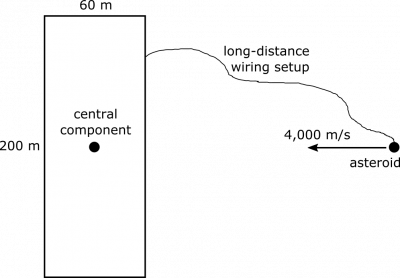This is an old revision of the document!
Example: Preventing an Asteroid Collision
Suppose your friend is vacationing in Italy, and she has lent you her spaceship for the weekend. You have gathered together a group of friends and you are currently cruising through the heavens together and having a great time. You are surrounded by nothingness in all directions. Suddenly, the radar starts beeping ferociously. The ship is on a collision course with an asteroid. You are not too worried about survival – the ship is practically indestructible. However, you know your friend would be devastated if you returned her spaceship with a scratch or dent from the asteroid. You need to prevent the collision.
You and everyone else on the ship has forgotten the combination to unlock the control room, and you don't want to disrupt your friend's peaceful vacation with worries about an asteroid, not to mention the outrageous rates on interstellar phone calls. You cannot change the ship's course. However, the message from the radar system may have given you some information you can use:
“The asteroid is coming from the due starboard direction with respect to the ship. The asteroid is approaching with a speed of 4,000 meters/second with respect to the ship. The asteroid has a mass of 20,000 kilograms. The asteroid has a charge of 50 Coulombs. As always, our ship is 200 meters long, and 60 meters wide. Collision will occur in 10 minutes.”
You get to thinking, and you remember there is another set of controls in an unlocked room. This set of controls is designed specifically to prevent asteroid collisions. The ship uses an advanced long-distance wiring setup to extract charge from the asteroid and bring it to a component located at the center of the ship. By charging the component, a repulsive electric force is generated between the asteroid and the component. Is it possible to charge the component in this way to prevent a collision? If so, what is the minimum amount of charge needed from the asteroid to prevent the collision? What happens if we extract all the charge from the asteroid (the component is charged to $50 \text{ C}$, and the asteroid becomes neutral)?
Facts
- The asteroid has mass $m=20000 \text{ kg}$.
- The asteroid has speed $v=4000 \text{ m/s}$.
- The asteroid has charge $Q=50 \text{ C}$.
- The ship is $200 \text{ m}$ long and $60 \text{ m}$ wide.
- The asteroid will reach the ship in $10 \text{ minutes}$.
- The asteroid is approaching from the starboard (right) direction.
- The central component can be charged using charge from the asteroid.
Lacking
- The current distance between the ship and the asteroid.
- The distribution of charge on the asteroid.
- The distribution of charge on the central component and on the ship itself.
Approximations & Assumptions
- We approximate the asteroid as a point charge.
- We approximate the ship as a rectangle (as seen in the representation below).
- We approximate the central component as a point charge.
- We assume the long-distance wiring setup is perfectly efficient. That is, no charge is lost to space and the charge of the asteroid and the charge of the central component will always add to $50 \text{ C}$.
- We assume that the rest of the ship is neutral.
- We approximate that the path of the asteroid goes straight toward the central component.
- We assume the system of the ship and the asteroid is closed, i.e., the energy of the system is conserved and there are no outside forces at all.
- The ship is currently floating through space, and therefore has constant velocity.
- The ship is far more massive than the asteroid to the degree that its current constant-velocity motion is not affected by the asteroid.
Representations
- We represent the electric potential energy of a point charge in the electric field of another point charge as $$U_r=\frac{1}{4\pi\epsilon_0}\frac{q_1q_2}{r}$$ This was derived in the notes here.
- We represent the example and its solution in the ship's constant-velocity reference frame.
- It will help to draw a representation of what we have decided about the problem above. We show our representation below.
Solution
We choose to solve this example using energy. The system is the asteroid and ship with nothing in the surroundings, so energy is conserved. We need to figure out a way to convert the asteroid's kinetic energy to electric potential energy before it reaches the spaceship. Its change in kinetic energy will be pretty straightforward to calculate (we'll plug in all the numbers at the end): $$\Delta K=\frac{1}{2}m(v_f^2-v_i^2)=-\frac{1}{2}mv^2$$
The change in electric potential energy will depend on how close the asteroid gets to the ship, and how we choose to charge the central component. Currently, its distance is $4000 \text{ m/s}\cdot 60 \text{ minutes/second}\cdot 10 \text{ minutes}=2.4\cdot 10^6 \text{ m}$. We also know $q_{comp}+q_{ast}=50 \text{ C}$, and we don't want the asteroid to approach the central component at a distance any closer than $30 \text{ m}$ (this is half the width of the ship, and the distance from the central component to the wall). For simplicity of calculation, we'll orient our coordinates so that the central component is at the origin, and the asteroid lies on the $x$-axis. We'll keep the initial and final positions of the asteroid as variables: \begin{align*} \Delta U &= \frac{1}{4\pi\epsilon_0}\frac{q_{ast}q_{comp}}{x_f} - \frac{1}{4\pi\epsilon_0}\frac{q_{ast}q_{comp}}{x_i} \\ &= \frac{q_{comp}q_{ast}}{4\pi\epsilon_0}\left(\frac{1}{x_f}-\frac{1}{x_i}\right)* \end{align*}
Ultimately, we want to figure out what $q_{comp}$ needs to be. $q_{ast}$ also depends on this, so let's solve for $q_{comp}q_{ast}$, using energy conservation, as we outlined earlier. We want $x_f>30 \text{ m}$, which leads to the following. \begin{align*} 0 &= \Delta U + \Delta K \\ &= \frac{q_{comp}q_{ast}}{4\pi\epsilon_0}\left(\frac{1}{x_f}-\frac{1}{x_i}\right) -\frac{1}{2}mv^2 \\ &< \frac{q_{comp}q_{ast}}{4\pi\cdot 8.85\cdot 10^{-12}\frac{\text{C}^2}{\text{Jm}}}\left(\frac{1}{30 \text{ m}}-\frac{1}{2.4\cdot 10^6 \text{ m}}\right) -\frac{1}{2}\left(20000 \text{ kg}\cdot\left(4000 \text{ m/s}\right)^2\right) \\ &= \frac{q_{comp}q_{ast}}{\text{C}^2}\cdot 3.00\cdot 10^8 \text{ J} - 1.6\cdot 10^{11} \text{ J} \end{align*}
This yields $$q_{comp}q_{ast}>\frac{1.6\cdot 10^{11} \text{ J}}{3.00\cdot 10^8 \text{ J}}\text{ C}^2=530 \text{ C}^2$$
Remember that we have the constraint $q_{comp}+q_{ast}=50 \text{ C}$. With this in mind, can we prevent the collision? Setting $q_{ast}=50 \text{ C}-q_{comp}$, we obtain $$q_{comp}(50 \text{ C}-q_{comp}) = 50 \text{ C} \cdot q_{comp} - q_{comp}^2 > 530 \text{ C}^2$$
A simple guess of $q_{comp}=q_{ast}=25\text{ C}$ yields $q_{comp}q_{ast} = 625 \text{ C}^2 > 530 \text{ C}^2$, which is enough to save the ship from cosmetic damage. To still save the ship while charging the central component minimally, one simply needs to solve the quadratic equation based on the inequality above: $50 \text{ C} \cdot q_{comp} - q_{comp}^2 = 530 \text{ C}^2$. An application of the quadratic equation or a quick query to Wolfram-Alpha gives a minimum charge of $q_{comp}\approx 15 \text{ C}$, which of course means $35\text{ C}$ remains on the asteroid. Notice that if we transfer all the charge from the asteroid to the central component, $q_{comp}q_{ast}=0$, since $q_{ast}=0$. If we do this, the asteroid will collide with the ship! It's worth convincing yourself that this result makes sense.
$*$Note about $\Delta U$: We include a $1/x_i$ term, which we know is very small, and will not contribute to the change in electric potential energy. Technically, this term shouldn't be there at all! This is because when the asteroid was located at $x_i$, before we even used the controls to create the long-distance wiring setup, the charge on the central component was 0, and there was no electric force on the asteroid at all. When we create the wiring setup, we also create a small amount of potential energy proportional to the $1/x_i$ term, which means the initial speed (initial here meaning directly after the wiring) actually is slightly less than $4000 \text{ m/s}$. To be exactly correct, we would need to either trash the $1/x_i$ term, or use a slightly lower initial speed – depending on when we want the “initial” state to be defined, either directly before or directly after the wiring. However, this difference is negligible, and the expression we have for $\Delta U$ as it is right now may be encountered again in other contexts, so we leave it alone.

